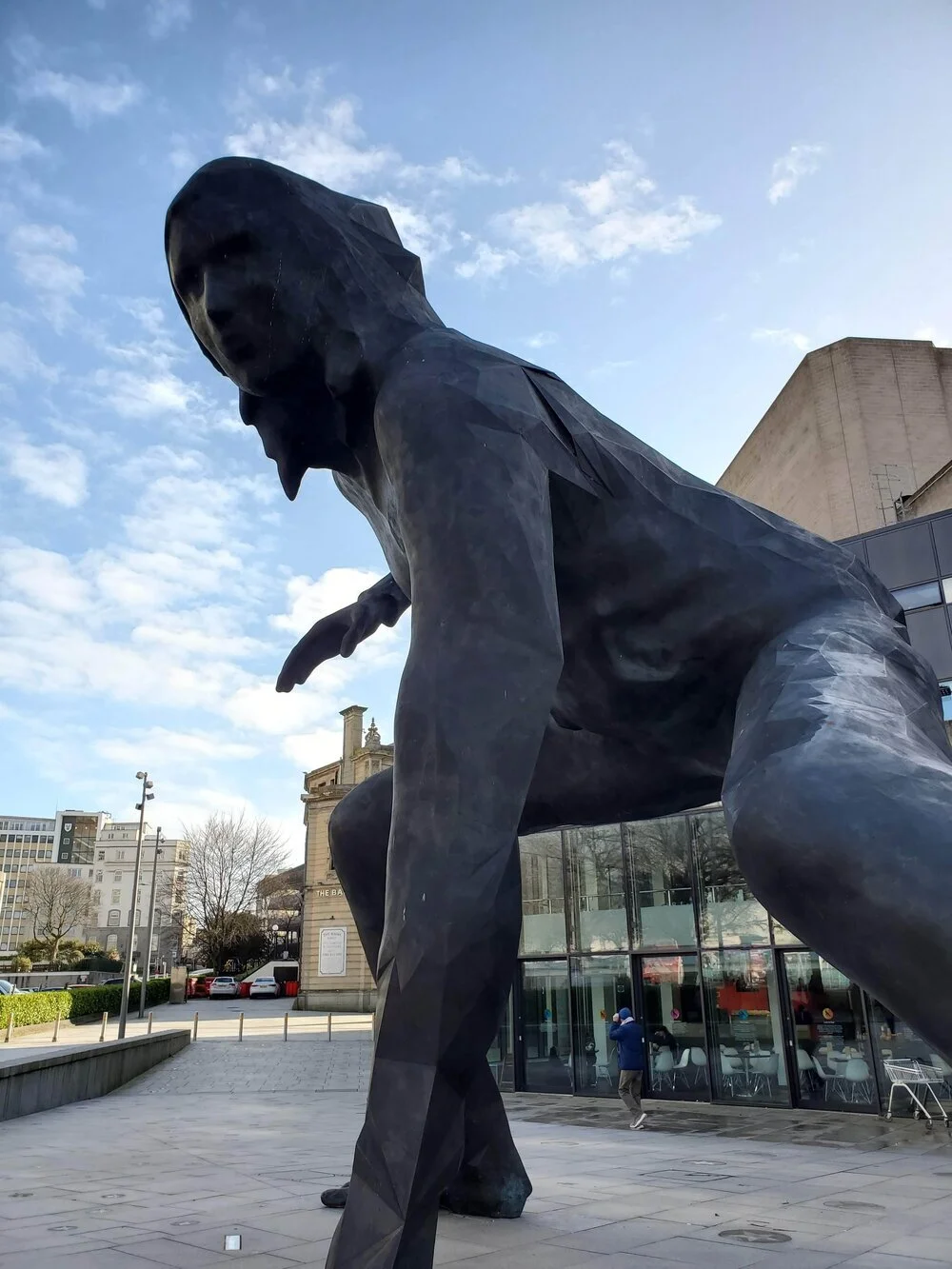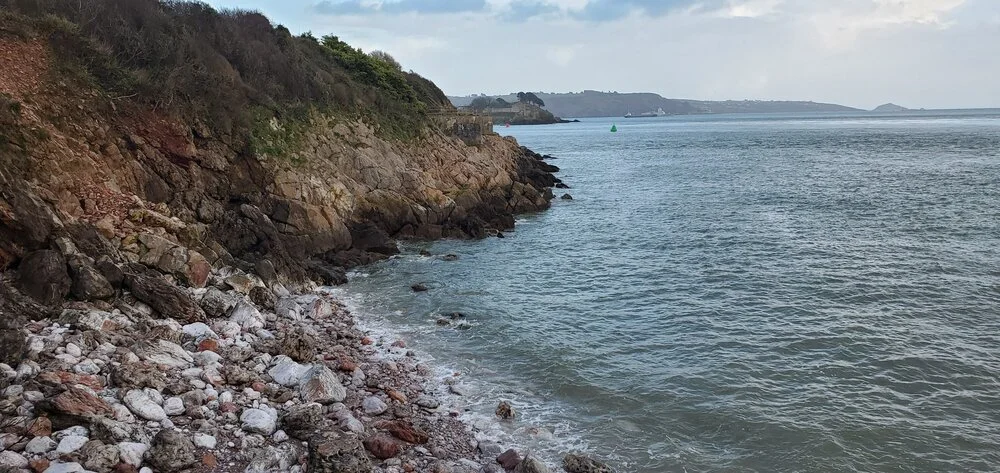Theatre Royal And Plymouth- Thursday, March 12th
Theatre Royal in background with Messenger by Nicola Kavanagh in foreground
On Thursday, Jade drove us about an hour Southwest of Paignton to Plymouth, where she runs an adult group at the Theatre Royal. The group, fully funded by the theatre, was called Our Space and engages adults that have disabilities, a history of substance abuse or a lack of networks. Her co-facilitator Ferry, an energetic, cheerful, and kind character, was also a past member of the group. We had a blast participating in the rehearsal of their futuristic space story, helping them flush out details and performance elements while being absorbed into their pieces as stand-in performers.
After the session we met Sarah Baldwin, the Engagement Manager from the Theatre Royal. It was very interesting to learn about the huge scope of their community engagement programs. They run 47 different groups for about 1700 clients and are staffed by 15 creative artist facilitators such as Jade. Many of their programs have a nominal fee to participate, but bursaries are available for people who need it. A few of the adult programs that stood out to us were: Funky Llama, which works to remove barriers for people with disabilities to engage in regular public events, festivals and outings; Journey’s, a heritage-based program in a deprived area working with refugees and other marginalized populations with a focus on connection and heritage; and CAMP, a project that works with homeless populations and uses forum theatre as tool for social change. A couple of the youth programs that we recall learning about were: Young People’s Learning Program, which works with schools all around the region and in Plymouth, using theatre to connect to other subjects; and Young Company which runs theatre, arts, and design workshops to provide opportunities for marginalized youth.
Because of massive nation-wide funding cuts saw many youth centres close, Theatre Royal also works to support many of the youth arts agencies that are already working in the area. They have many opportunities that come through this model and work with 200 + community partners for groups and projects. One of their partnerships include Frantic Assembly which is a physical theatre assembly supporting young men 16-25 in movement and dance with the Birmingham Royal Ballet on a performance piece called Dreams by young people.
Sara had also been gearing up for a big show that was set to open a week later. However, it was stained with her growing apprehension about its possible cancellation due to Covid-19, as the World Health Organization had declared it a Pandemic just the day prior. (It has ended up being postponed until later notice) It was a bit ironic as This Land is a piece that marks the 400-year anniversary of the Mayflower and tells the story of the disastrous impacts that it had on the Native American Wampanoag people, which included the spread of an infectious deadly disease. Fittingly, the Wampanoag performers carried much apprehension about their slated travel plans to the UK during the current Pandemic. This Land is a community production to be performed by 120 community members and 30 members of the Wampanoag Tribe in Massachusetts, USA, who partnered through an international collaboration to share the significant historical impacts of the Mayflower pilgrimage for the first time in history.
Plymouth has a bit of a turbulent history, being flattened in World War II bombings by German troops, it took time to rebuild the city which has since endured a struggling economy and higher levels of unemployment than the rest of the country. Theatre Royal and their partners have developed a wide variety of supports for marginalised and low-income citizens, bringing them greater access to the arts and new opportunities for growth and development. When our visit with Sara ended, Stephanie made her way back to Paignton with Jade, while Alia decided to stay the night in Plymouth with Jades offer of a comp ticket for the evening show, and to take advantage of her location to go on a hike the next day.
Messenger by Nicola Kavanagh
Plymouth
Alia’s Story:
With a few hours to kill I checked into my room for the night to drop off my bags and wandered around town a bit. Curiosity brought me into The Plymouth Scrap Store where I ended up in conversation with the owner about their business and structure for over an hour. She generously and unexpectedly gave me a full tour of the upstairs storage warehouse which I drooled over as it was a materials haven for makers such as myself. The organization collects donated materials such as unused paint, tiles, rolls of foam, fabric ends, building materials, crafting supplies, and play equipment from large organizations and households, diverting it from the dump. They sort and organize the materials into their building to sell back to the community for a fair deal. In addition, they also host community workshops; at the time there was a group using a large fabric donation to make tote bags which had made their way around the city and were even being distributed at some of the supermarkets instead of plastic bags. It seemed like a great place to find odds and ends for crafting and creating, or even just to wander through for inspiration on the next project. I would love to have access to something like this in Calgary.
Plymouth scrap store
Before the show, I took some time to visit the largest bronze sculpture in the UK. A piece of public art called The Messenger, portraying a woman crouched with legs wide and one hand pressing into the ground supporting her stance. It was created by Cornish-born sculptor Joseph Hillier who was inspired by an actress' pose while rehearsing Othello at the Theatre. Hillier says he named it after the "pivotal" role of a performer to "breathe life into words". The plaque displayed described it as a very exciting spectacle for Plymouth as it entered the maritime city fully constructed by ship just one year earlier. It did feel like a monumental work as I stood at her feet looking up at the 23-feet of her body towering over me. The 25-foot archway formed by the space between her legs also presented quite the grand entrance to the front doors of the Theatre Royal. The bronze still dawned a significant layer of its wax coating giving it the appearance of having a darker color but there were little sections of brilliant bronze and patinas of blues and yellow starting to peek through her heels which hinted at how the work would transform and become more beautiful over time.
I finally made my way into my seat at the theatre to watch the performance of 808 by the renowned Robert Lepage, which was a work about memory and his childhood in Quebec in the 1960s. Although I was a bit turned off by Lepage’s shameless self-indulgence, which made it hard for me to maintain focus for the full two-hour fragmented biographical monologue, his genius in staging and set design was undeniable. His set started out as a to-scale model of the facade of his old apartment building with detailed balconies, doors and lighting. The windows were individually animated using video to illustrate the individual narratives of each family in the building. The set revolved and transformed, opening up to reveal the functional interior of his own apartment building as an adult which he entered into, shifting again to become the inside of a local bar, shifting again to become a projection screen and then the inside of their family’s garage complete with the interior of his father’s car. He played a lot with scale by butting life sized environments up together with model-sized objects and using video to transport the viewer into his constructed environments. The visuals and interactivity of his complex and shape shifting multifaceted set was super inspiring.
After the show, I settled immediately into my bed to get a good night rest for my hike the next day.
Plymouth





